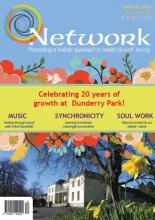Psychosynthesis and Ireland's Crisis of Faith

This article is based on my recent dissertation on the topic of Psychosynthesis psychotherapy and its application and place in the Irish context. I sees a place for broadening the discussion on this important branch of humanistic, transpersonal psychology in light of the prevailing spiritual emergency and crisis of faith encountered by much of the Irish population. In the wake of the church scandals and collective shadow that has been made more explicit in recent years, psychosynthesis may provide a mode of self-discovery that assists us to separate and individuate ourselves in terms of our religious denomination and spiritual self. This paper will incorporate a multi-modal perspective on aspects of the integrative developmental journey of Ireland as a nation.
Ireland and its Psychic Structural Development
The psychological structure of Ireland as a collective entity has been fraught with disintegration, fragmentation and trauma in its modern history. On a geological level, Ireland and Britain were separated from mainland Europe during the last glacial period around 16,000 BC. A mostly forested island, the first settlers arrived during the Mesolithic and Neolithic periods and later the innovation and industry of the Bronze and Iron Ages heralded the emergence of Celtic culture and language. A nomadic way of life and our close proximity to nature, animals and wilderness was a hallmark of early Celtic shamanic peoples. The unifying of the nation could be said to have been at its best during this period, in which it largely evaded the conquest of the Romans. Spiritual life included the worship and celebration of deities such as Lug and Anu who were figures representing poetry, music, prosperity and the harvest These were aspects of the creative nature of Ireland’s inhabitants of the time and whose works of art can still be viewed in the Ogham stones and monuments like the Navan Stone. However this culture also included war like factions on the edge of society in the form of ‘fians’; a term later revised as ‘fianna’ which remains as a descriptor of Irish political parties today. Although rivalry existed between small scale kingdoms there was relative cohesion leading into the time of the High Kings around the 7th century.
Following on from this Ireland was subjected to recurrent conquests, pillaging and extortion at the hands of the Vikings, the Normans and the British. It also experienced the great famine of the 18th century which left it further wounded and traumatised. The 20th century saw the war of independence and later, the announcement of the Free State in 1949. This liberation was however overshadowed by splitting of a sovereign, geographical and ultimately psychospiritual nature due to the partition between the north and the republic, the troubles of which would remain until 1998. Splitting and projection, both characteristic of paranoid schizoid anxieties were the fragile defences used to negotiate this re-forming of the collective ego. It may be said that what followed in the form of the manic rise of the Celtic tiger and the subsequent lull of the recession were the recapitalisation of our depressive phase as a nation which carries large developmental deficit and is unsure of its identity. Unable to integrate its own wounding and shadow, not the least of which was exposed during the church scandals and enquiries, there is indeed a great crisis of faith at hand and we stand on uneven ground psychologically in terms of the many subpersonalities of the Irish character which operate via dissociative distance.
Ireland now has a greater understanding of the danger of projecting our highest qualities into the omnipotent Other or God. Where we deny our highest potentiality and authenticity this is doomed to result in destructive defence systems within the collective. Denial and disavowal of human sexuality, illegitimating of children, banishing of women, banishing of the feminine energies occurred in an abdication to the power of the church. It now raises the question of whether we can accept our own shadow, sexuality and darker emotions without abdicating our responsibility for these elements to an omnipotent Other. Can we find a way to integrate the higher and the lower end of a wider moral compass? In breathing in a whole breath deep breath to our depths can we exhale in the knowledge that we are both the depths and the heights, the darkness and the light… rooted and reaching?
A Psychosynthesis Perspective on Psychopathology
Traditional psychiatry in Ireland centered around asylums such as Grangegorman before a move in the late 20th century towards deinstitutionalization and a stronger emphasis on pharmaceutical drugs. Acclaimed psychiatrist, Ivor Browne has elaborated on the fact that while patients may not be incarcerated, they remain institutionalized by pharmaceutical drugs. Browne has suggested that since the shift to prescription drugs in the treatment of mental health, disorders such as bi-polar are more widespread and sustained exacerbated by the lack of resources within the health services such as psychotherapy which target the root of the persons suffering and wounding. Browne like many others in the field advocates the research into epigenetics and the evidence that traumas may be passed down the genetic line along with predisposition towards physiological disease and this is relevant in terms of the traumas that befell Ireland in recent history as covered in the introduction. Indeed primal wounding, or failure of love and empathy in early life is seen by many theorists in psychodynamic and psychosynthetic schools as the deepest trauma one can carry. Therefore by failing to address the traumatic experiences of mental health sufferers, we fail to provide an opportunity for the source of the egoic wounding and ultimately the symptoms to be dealt with and integrated. The DSMV refers primarily to “pre-egoic and damaged egoic states of being” and points out that the transcendence of personal egoic consciousness offers the opportunity for transformation postulating that this may be spontaneously occurring in states that may be misdiagnosed, for example as schizophrenia and borderline.
Contemporary psychosynthesis points to primal wounding being at the foundation of negative experiences like depression and anxiety, where a predisposition to these dilemmas is rooted in early non empathic experience which instil the fear of ‘non being’. Psychosynthesis views addictions and compulsive patterns as an attempt to bridge the lower and higher unconsciousness by avoiding and failing to integrate wounding. Addiction is a form of toxic synthesis which traps the manifestation of higher or peak experiences so that they may only be experienced artificially within the addiction. Psychosynthesis sees depression as the internalisation of the oppressor and the lingering essence of early non empathic unifying centres. However it also proposes that this dynamic may contain higher qualities such as connection, hope and truth albeit as the antithesis to the early trauma bonding; the presence and ‘knowing’ of the other potentiality of the Self not taken up. In borderline the primal wound is so intense that the slightest empathic failure will trigger lower unconscious pain and in bi-polar; traumatisation at an early stage has caused an experiential split and absolute divide between the lower and higher unconscious. In dissociative identity disorder, very problematic primal wounding was reacted to by sharing the overwhelming task of functioning and holding the tremendous pain between various subpersonalities. These fragments operate via dissociative distance from each other and although it may be destructive this inner response is seen by psychosynthesis to also hold higher qualities like creativity.
Recent research suggests that psychosynthesis psychotherapy was effective in it use of active imagery with schizophrenia and generalised anxiety whereby images were linked to fragments of the frozen present and anxiety could be given form helping the sufferer to conceptualise this. Psychosynthesis holds that in severe psychotic breakdown, there may also be a radical expansion of the patients layers of consciousness and that some ‘hallucinations’ and ‘delusions’ may indeed be the sufferers experience of collective or superconscious energies. Roberto Assagioli, along with colleagues like Henri Baruk maintained that in every patient regardless of pathology and severity there is a part of them that remains unaffected and this can be reached by the therapist . With that being said more recent research emphasised that assessment as always is key. In line with Ivor Browne’s take on psychopathology in acute psychosis medication may be needed to bring the patient back to reality such that contact and response can be established. Severe psychopathology is rooted in fragile ego constructs which also includes the struggle of being ‘awake’ in the insanity of the overdeveloped collective ego. Greater totality of being may also include intensely pure feelings of desolation and despair as well as peak experiences and this can make the task of integrating this experience difficult for the psyche.
Place and Efficacy of Psychosynthesis in the Irish Context
Cognitive Behavioural Therapy (CBT) still seems to be the most prevalent modality offered by the health service despite longitudinal meta-analyses showing that humanistic, integrative, psychoanalytic and system modalities were equally effective. In 2006, the Department of Health and Children issued a document called ‘A Vision for Change’ in conjunction with review of mental health services in Ireland. This paper raised concerns about the lack of uniformity around training standards and the cost efficiency across various modalities of psychotherapy and psychoanalysis. Notedly, the same document envisaged that a mix of “psychological therapies, creative and recreational therapists” being the best practice treatment approach for mental health This raises the question of whether psychosynthesis which marries work with imagery, meditation and psychotherapy could be a modality that ascribes to this vision whilst remaining more cost effective than providing psychotherapy, mindfulness and art therapy on a separate basis. A longitudinal study completed for ICP lists exhaustively the issues that other modalities such as CBT and psychoanalytic psychotherapy are useful for, however the top issues most effectively addressed by psychosynthesis according to the field research are not listed, namely: existential crisis of faith/spiritual emergency and issues of identity.
During recent research completed by Dublin Business School, the consensus of the participants was that psychosynthesis among other transpersonal approaches remains undistinguished from Christianity by the Irish public and are therefore avoided. It was felt that the churches influence has left many scars, not the least of which have emerged through reports into clerical sexual abuse as was emphasised in an IAHIP interview with Brother Mark Hedderman. Several texts from within the church have been written on this topic including A Question of Conscience by Father Tony Flannery. Ambivalence remains with some authors citing the link between the church run psychiatric facilities as a predictor for mental health while others emphasize the need to hold on to ones faith in the interest of maintaining mental wellbeing. The Census 2016 reported a decrease in Catholic population from 92% - 78% during 1991-2016 with the second largest group described as having ‘no faith’.
Some of the other barriers and limitations highlighted in the study by Dubline Business School pointed to the many requirements financially and regulatory in terms of re-establishing a Psychosynthesis Institute in Ireland. In addition as statutory regulation nears, there is a sense that approaches of a scientifically quantifiable nature will be preferred in line with the medical model.
Conclusion
A desire for synthesis and wholeness within the collective culture is evident in the Ireland of today, following marriage equality, a decrease in tensions between the north and the republic and an emerging cosmopolitan societal split. We are in a process of reinvention and realignment and this is not without its difficulties and dilemmas. As with clients of individual psychotherapy, we will not easily part with our protective subpersonalities and the safety of our identification with religious and patriotic figures. The task is to slowly integrate our wounding whilst forming a new collective psychic structure that does not forget its roots and yet is not afraid to reach towards self-actualisation. This paper has looked at the traditional interventions used to react to mental ill health which once more were closely associated with church led institutions. In disidentifying from the more dated models of treatment we open ourselves to other creative forms of therapy such as psychosynthesis which provide grounding as well as safely restoring a connection to something more than ourselves. The modality is popular in the USA and UK with demonstrable results in psychiatric settings as well as hospices, schools and the general public. Continued research and psychoeducational awareness would lend itself to the expansion of the approach in Ireland. Perhaps the future of Irelands revolutions and uprisings will be a psychic affair as we begin to bridge our fragmented past around a bright and inclusive unifying centre of Self.
Wayne Hamilton BA (Hons) is a qualified counsellor and psychotherapist and founder of RISE Counselling in Kilcoole, Co. Wicklow. He also works for charitable organisations like Rehabcare and Living Life Counselling in Bray. Wayne has special interest in attachment issues, grief, sexuality, gender and the transpersonal sphere. He can be contacted via:
Latest Issue
Upcoming Events
-
17/04/2020 to 26/04/2020
-
18/04/2020
-
23/04/2020
-
15/05/2020 to 23/05/2020
-
16/05/2020 to 17/05/2020
Recent Articles
Article Archive
- November 2011 (2)
- January 2012 (3)
- February 2012 (2)
- March 2012 (2)
- April 2012 (4)
- May 2012 (4)
- June 2012 (1)
- July 2012 (3)
- August 2012 (2)
- October 2012 (2)

